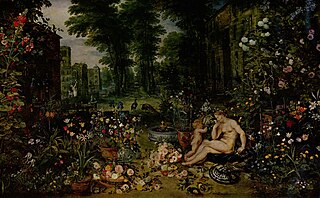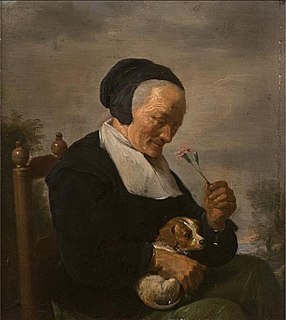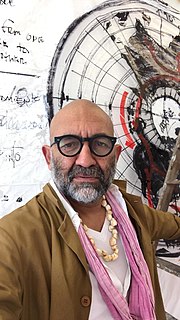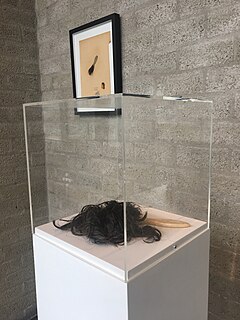
Maki Ueda (born 1974, Tokyo) is a Japanese artist. She is currently based in Okinawa and Tokyo, Japan. [1] [2]

Maki Ueda (born 1974, Tokyo) is a Japanese artist. She is currently based in Okinawa and Tokyo, Japan. [1] [2]
Maki Ueda studied media art under Masaki Fujihata at The Environmental Information Department (B.A. 1997, M.A. 1999) at Keio University, Japan.
Ueda is known for her work that focuses attention on fragrance with minimal influence from the other senses, [2] and is considered an important pioneer in the medium of olfactory art.
Her 'Olfactory Labyrinths' series consists of installations that must be navigated by nose alone. Thus the participant must rely on their experience of smell without other sensorial inputs.
Contributing to a show called “If There Ever Was: An Exhibition of Extinct and Impossible Smells,” at the Reg Vardy Gallery in Sunderland, England in 2009, Ueda's piece “ summoned the body odor of political suspects in East Germany, carefully stored in jars by the Stasi in order to track them someday with dogs.” [3]
In 2011, Ueda was invited to be a guest curator [4] for the Palm Top Theater exhibition for V2_, Lab for the Unstable Media in Rotterdam, Netherlands. [5]
Ueda is also known for her work with Kodo, educating people about the practice while teaching about olfactory games with her course Smell and Art at the ArtScience Interfaculty program of the Royal Academy of Art and Royal Conservatoire in the Hague, Netherlands. The course ran between 2009 and 2018. In the Olfactory Games curriculum, she drew from traditional Japanese scent games known as Kōdō, taking their conceptual and abstract approach to the medium of smell to extrapolate other types of game play. [6]
Maki Ueda has been nominated for the Art and Olfaction Awards Sadakichi Award for Experimental Work with Scent on multiple occasions. She was nominated for the following works: 'The Juice of War' (2016), 'Olfactory Games' (2018), 'Tangible Scents: Composition of Rose in the Air' (2019), 'Olfactory Labyrinth V. 5: Invisible Footprints' (2020). [7]
Maki Ueda was nominated for The World Technology Awards (Category: Art) in 2019. [8] She received the POLA Arts Foundation grant in 2007. [9]

Linda Brown Buck is an American biologist best known for her work on the olfactory system. She was awarded the 2004 Nobel Prize in Physiology or Medicine, along with Richard Axel, for their work on olfactory receptors. She is currently on the faculty of the Fred Hutchinson Cancer Research Center in Seattle.
The docking theory of olfaction proposes that the smell of an odorant molecule is due to a range of weak non-covalent interactions between the odorant [a ligand] and its protein odorant receptor, such as electrostatic and Van der Waals interactions as well as H-bonding, dipole attraction, pi-stacking, metal ion, Cation–pi interaction, and hydrophobic effects, in addition to odorant conformation. While this type of recognition has previously been termed the shape theory of olfaction, which primarily considers molecular shape and size, this latter model is oversimplified since two scent molecules may have similar shapes and sizes but different sets of weak intermolecular forces and therefore activate different combinations of odorant receptors. Earlier “lock and key” and "hand in glove" models of protein−ligand binding has been replaced by a more nuanced pictures which consider the distortion of flexible molecules so as to form the optimal interactions with binding partners as in molecular docking of non-olfactory G-protein coupled receptors.
Luca Turin is a biophysicist and writer with a long-standing interest in bioelectronics, the sense of smell, perfumery, and the fragrance industry.

Cornelia Isabella "Cori" Bargmann is an American neurobiologist. She is known for her work on the genetic and neural circuit mechanisms of behavior using C. elegans, particularly the mechanisms of olfaction in the worm. She has been elected to the National Academy of Sciences and had been a Howard Hughes Medical Institute investigator at UCSF and then Rockefeller University from 1995 to 2016. She was the Head of Science at the Chan Zuckerberg Initiative from 2016 to 2022. In 2012 she was awarded the $1 million Kavli Prize, and in 2013 the $3 million Breakthrough Prize in Life Sciences.

An odor or odour is caused by one or more volatilized chemical compounds that are generally found in low concentrations that humans and animals can perceive by their sense of smell. An odor is also called a "smell" or a "scent", which can refer to either a pleasant or an unpleasant odor.

The sense of smell, or olfaction, is the special sense through which smells are perceived. The sense of smell has many functions, including detecting desirable foods, hazards, and pheromones, and plays a role in taste.
Christophe Laudamiel is a French perfumer. He is founder and master perfumer of DreamAir creative studios in New York City, where he currently resides. In 2019 he was named chief perfumer to BélAir Lab in Tokyo: a perfume composition and technology studio newly managed by Roto Pharmaceuticals. He is a founder and president of the non-profit Academy of Perfumery and Aromatics.

Digital scent technology is the engineering discipline dealing with olfactory representation. It is a technology to sense, transmit and receive scent-enabled digital media. The sensing part of this technology works by using olfactometers and electronic noses.

Sissel Tolaas is a Norwegian artist and researcher known for her work with smell.

The Art and Olfaction Awards are a non-profit award mechanism designed to celebrate excellence in international artisan, experimental and independent perfumery and olfactory art through a yearly blind-judged competition.
The Institute for Art and Olfaction is a non-profit organization devoted to advancing public, artistic and experimental engagement with scent. It was founded in 2012.

Oswaldo Maciá is a sculptor. Born in Cartagena de Indias, Colombia, he is based in London and New Mexico, USA. Maciá works primarily with sound and smell. In his work he endeavours 'to extend the meaning of sculpture' beyond an ocularcentric understanding of the arts.

Olfactory art is an art form that uses scents as a medium. Olfactory art includes perfume as well as other applications of scent.
Peter de Cupere is an olfactory artist who lives and works in Antwerp. De Cupere creates work intended to explore experiences of smelling.
Geza Schön is a German master perfumer born in Kassel and based in Berlin. He trained at Haarmann & Reimer and has worked with Diesel, Ormonde Jayne, FCUK, biehl parfumkunstwerke, and Boudicca. In 2006, Schön created the brand Escentric Molecules, a perfume brand highlighting single molecules. He received the Outstanding Artist Award for Interdisciplinarity in 2016, then, in 2017, the Sadakichi Award for Experimental Work with Scent, together with Wolfgang Georgsdorf for "Osmodrama / Smeller 2.0".
Osmodrama: from the Greek osme (smell) and the ancient Greek dráma (plot), describes the performance of time-based olfactory art using the experimental scent-playing ‘organ’ Smeller 2.0, as well as the festival Osmodrama – Storytelling with Scents.
Wolfgang Paul Georgsdorf is an Austrian media artist, director, sculptor, musician, author, researcher, and inventor based in Berlin. He was founder and spokesman of Opal-so-nicht which resulted in a successful case against Gazprom and BASF in Dahme-Heideseen Nature Park, Brandenburg, Germany.
Josely Carvalho is a Brazilian artist who is based in New York City and Rio de Janeiro.
Brian Goeltzenleuchter is an American olfactory artist and educator.
Ann-Sophie Barwich is a cognitive scientist, an empirical philosopher, and a historian of science. She is an Assistant Professor with joint positions in the Cognitive Science Program and the Department of History and Philosophy of Science at Indiana University Bloomington. Barwich is best known for her interdisciplinary work on the history, philosophy, and neuroscience of olfaction. Her book, Smellosophy: What the Nose tells the Mind, highlights the importance of thinking about the sense of smell as a model for neuroscience and the senses. She is also noted for her analyses on methodological issues in molecular biology and neuroscience.